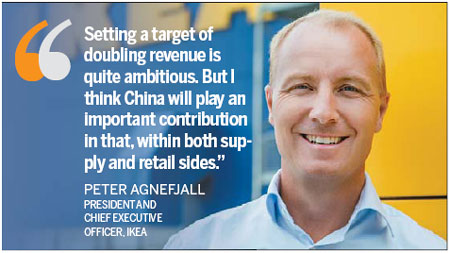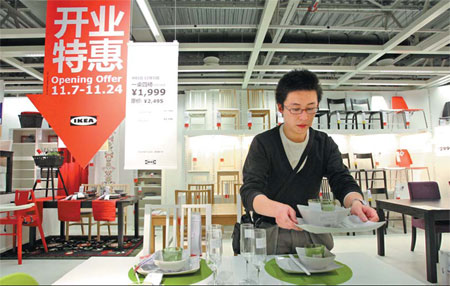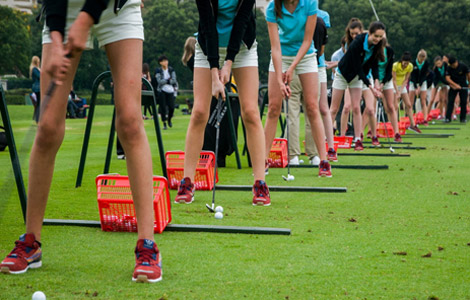Assembling a strategy for the future
By Li Fangfang ( China Daily Europe ) Updated: 2013-11-15 09:57:32
Slowly, surely, sustainably but also with ambition: That is Ikea's model for China
Peter Agnefjall says he never makes blind forecasts. "In Ikea, we think about and look to the long term."
However, the new president and chief executive officer of the Swedish furnishing giant recently launched a new long-term strategy alongside his predecessor Mikael Ohlsson with the target of doubling the group's annual sales to 500 billion euros by 2020. They did this just before his new title took effect on Sept 1.
"That means we need to grow by 10 percent a year during the period between 2013 and 2020," Agnefjall says. "From my perspective, we are still just at the beginning of our journey."
The 42-year-old Swede says he will continue to keep Ikea on a stable development track. He has been with the company since 1995, starting as a trainee on a one-year program.
"I was deeply influenced and had a really good insight into the company, from an important element in experience working as the assistant to three former group CEOs," Agnefjall says. "I am a typical Ikea worker and will always be."
Wearing a simple white shirt with sleeves rolled up and ordinary blue jeans, Agnefjall does not look like a traditional CEO but does resemble his colleagues, who were influenced by the company founder Ingvar Kamprad, a man famed for being thrifty and hardworking.
"Setting a target of doubling revenue is quite ambitious," he admits. "But I think China will play an important contribution in that, within both supply and retail sides, because we are still facing challenges in European markets following the slowdown of the economies there."
Because China has maintained the fastest growth for Ikea worldwide, "the revenue in this market will grow more than double by 2020".
Agnefjall's confidence in the Chinese market is not without good reason.
|
Ikea's second store in Beijing opened on Nov 7 to service customers from the southern part of the city. Zhang Wei / China Daily |
Ikea was a latecomer to the world's fastest growing economy, setting up in 1998. Its second store in Beijing opened on Nov 7 in Daxing district.
Fredrik Johansson, manager of the new store, said that to be more locally relevant to people living in south Beijing, the company prepared a different layout in the store to present its 9,000 articles.
Ikea now has just 14 stores in 11 cities in China, a small number for a group that operates about 350 stores in 44 countries.
However, in its 2013 fiscal year that ended on Aug 31, Ikea's revenue in China surged 17 percent to 6.3 billion yuan ($1.03 billion; 773 million euros) from a year earlier. The Swedish company also saw year-on-year growth of 12 percent in store visitor numbers to more than 45 million and a 33 percent rise in website visits to more than 30 million.
"I expect our business in China to maintain double-digit growth and sustainable development in the near future," Agnefjall says.
"And I am sure China will be one of the major destinations for our investments in new stores, existing stores, factories, product development and in lowering prices for us to commit to the Ikea vision of 'creating a better everyday life for the majority of people'."
Slow but stable
In 1998, IKEA opened its first store in Shanghai, and a year later the second in Beijing. However, the furnishing company suspended expansion for five years until it opened the third store in Guangzhou in 2005.
"We don't focus on short-term increases or act quickly. For Ikea, it's more important to have a good understanding of the market and customers because we see China as an important market for us to create a better life for many people," Agnefjall says.
"At the beginning, it took a long time to understand the Chinese market and customer demand. We paid visits to hundreds of homes to learn people's habits and what they needed."
After developing a stable foothold in the Chinese market as a renowned brand representing a North European lifestyle, the Swedish company started to accelerate its retail network expansion from 2008, opening at least one new store every year.
"We are opening three new stores this year, with a third one in Shanghai and this second one in Beijing. And Ikea will have another three new stores next year," Agnefjall says. Ikea aims to have 17 stores in China by 2015.
Liu Jinliang, deputy secretary-general of the China National Furniture Association, says the furnishing sector in China still has a bright future.
"It's an evergreen industry in China because there is always natural demand for real estate in the long term, especially from the more than 10 million newlyweds every year," Liu says. "Rapid urbanization also drives the requirement for furniture."
According to Liu Chang, an analyst with consulting firm Roland Berger Strategy Consultants covering the retail and furnishing industries, China's furnishing market maintained an average annual growth of 11 percent between 2008 and 2011.
"It's a huge market of about 2.3 trillion yuan," Liu says. "Urbanization, newlyweds and increasing demand for a better life will help the market maintain a momentum of about 10 percent year-on-year growth till 2017."
Although it has huge potential, Liu says the industry is too segmented with many small Chinese enterprises.
"In past years, the competitiveness of furnishing companies in China was contained within product quality and distribution channels. However, discerning shoppers increasingly demand a better lifestyle and now look to branding and design," Liu says.
He says that Ikea's regional expansion to lower-tier cities will be a sustainable engine to further drive its business in China after the company's relatively conservative development in the early years played on market hunger in many places that lacked Ikea stores.
He also suggests Ikea pay attention to its strategy in first and second-tier cities.
"The upgrading of products according to customers' increasing demand and requirements is essential to future development," Liu says.
Although there is a bright future for the domestic furnishing market, for Agnefjall, the furnishing giant's fifth CEO, there is little more important than its retail business in China.
"Yes, we have stores in many countries. But none of them has the same importance as the Chinese market to Ikea," Agnefjall says.
The Asian market only contributed 6 percent to the company's global revenue and China accounted for just 2 percent.
Impressively, "China is our top sourcing country, with 22 percent of Ikea's global purchasing coming from about 300 Chinese suppliers," Agnefjall says.
He says that the company's recent move of opening the first wholly- owned manufacturing facility in the country indicated Ikea's further determination to make China its manufacturing hub.
Located in Nantong, Jiangsu province, the factory will produce wooden products to supply Ikea stores mainly in China. With this facility, Ikea will have 43 manufacturing units in 12 countries.
"Having a wholly-owned factory helped Ikea to have a complete value chain in China, after we set up our two biggest warehouses and a test laboratory in Shanghai," Agnefjall says. "It also actively enables us in our long-term efforts to continuously cut product prices for local customers."
Providing more relevant and affordable solutions to millions of potential Chinese customers, with quality products at lower prices is Ikea's strategy. It cut product prices in China by an average of more than 50 percent between 2000 and 2013.
Greener future
Agnefjall is also committed to making Ikea even greener, through its sustainability strategy set for 2020.
"Ikea is likely to make a small but important contribution to society," he says. First, Ikea "should enable people to live a more sustainable life at home".
"We welcome 700 million visitors to our stores and have 1 billion online visitors every year. If we can encourage just a fraction of those to start using an induction hob or to install an LED bulb instead of a conventional light bulb, then things are taking a step in the right direction," he says.
Disclosing that Ikea just installed its 500,000th solar panel worldwide on the roofs of Ikea buildings, Agnefjall says that the second step is that "Ikea would like to become energy-independent, which means that we will produce the same amount of sustainable energy within the group as we consume by 2020".
In July, Ikea announced it is cooperating with Chinese solar company Hanergy Holdings Group Co Ltd on a grid-connected solar power generation project for all of the Ikea stores in China as well as Ikea's selected suppliers.
The partnership will also expand to the global market because Hanergy will sell solar power generation equipment to Ikea's customers in the United Kingdom.
"That's my ambition: to create a better life for many people. It's not about selling products or business growth. It's sustainability for a positive life," Agnefjal says.
lifangfang@chinadaily.com.cn
(China Daily European Weekly 11/15/2013 page22)
|
|
|
|
|
|
|
|
European Weekly
 Gear change
Gear change
'Sustainable development', 'decisive role for markets' are the new buzzwords for Chinese economy.





















